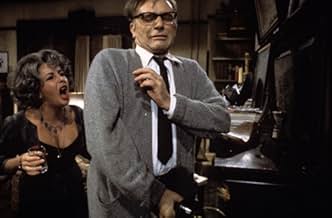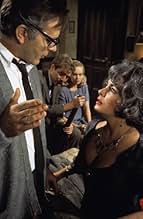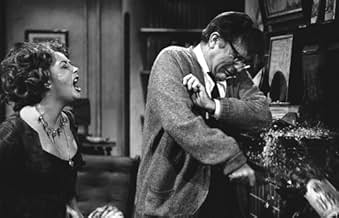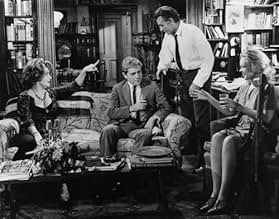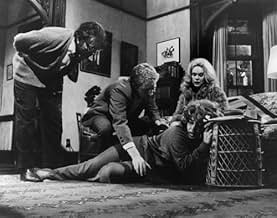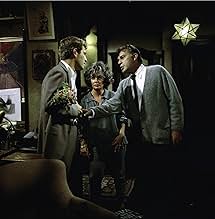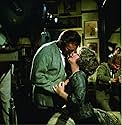A middle-aged New England associate professor and his wife, with the help of alcohol, use their young guests to fuel anguish and emotional pain towards each other over the course of a distre... Read allA middle-aged New England associate professor and his wife, with the help of alcohol, use their young guests to fuel anguish and emotional pain towards each other over the course of a distressing night.A middle-aged New England associate professor and his wife, with the help of alcohol, use their young guests to fuel anguish and emotional pain towards each other over the course of a distressing night.
- Won 5 Oscars
- 22 wins & 26 nominations total
- Director
- Writers
- All cast & crew
- Production, box office & more at IMDbPro
Featured reviews
Simply put, this is one of my favourite films of all time. Great acting, great writing and great camerawork make this close to cinematic perfection. Liz Taylor and Richard Burton give the performances of their lives. Sandy Dennis also shines in an early-ish role. It's a dramatic film, but the wicked humour that permeates the film is absolutely devastating, and I mean that in the best possible way. Many moments in the film I find myself laughing only to think, "Should I be laughing at this." Certainly the film is loaded with uncomfortable moments, enhanced by the camerawork replete with uneasy close-ups. Most of all, this film shows how a lot can be accomplished with just a little: a cast of four and minimal scenery changes. "Who's Afraid Of Virginia Woolf" has become an absolute icon of American cinema. If you haven't seen it, what are you waiting for?
Edward Albee's award winning play, Who's Afraid of Virginia Woolf ran for 664 performances on Broadway and just closed down when this film version made its debut in 1966. The Broadway play was set entirely in the living room of George and Martha's home and starred Uta Hagen, Arthur Hill, Melinda Dillon, and George Grizzard. All eminently respectable players, but none of them exactly movie box office.
This film was destined to make money when the most publicized couple of the decade, Elizabeth Taylor and Richard Burton, chose it as a star vehicle for themselves. Of course what was not clear was how well a one stage play would adapt to film.
It adapted very well and went quite beyond one stage. The action of the film moved effortlessly to an all night diner at one point with some stops along the way. You'd hardly know the story as originally told only had one setting.
There's no real plot to it. For reasons I can't fathom this middle aged and bitter couple George and Martha have a younger couple, Nick and Honey, over to their house at two in the morning. I don't know about you, but I'm usually not my best at that time. Also they had just come from a party at Martha's father's house. Martha's dad is the president of a college and George teaches there. Nick and Honey are a newly hired professor and his wife.
The late night and the liquor bring out the worst in everybody. A whole lot of ugly truths get told.
Who's Afraid of Virginia Woolf was the summit of the professional team of Elizabeth Taylor and Richard Burton. Playing against type, Elizabeth Taylor got her second Oscar the one she felt she earned. She always disparaged the one received for Butterfield 8 as it came on the heels of her well publicized pneumonia bout.
In fact all four members of the cast were nominated with Sandy Dennis winning Best Supporting Actress. Ironically Richard Burton didn't win, losing to Paul Scofield for A Man for All Seasons. I guess the Academy voters figured Burton would get another shot. He never brought home the big prize though.
George Segal usually gets overlooked. This film and Ship of Fools was the start of his long career, but no Oscar for him either.
Who's Afraid of Virginia Woolf is quite the indictment against marriage, especially after the love has died. It's far from the whole story of marriage. There are many who stay married longer than George and Martha and happily. But it wasn't in Edward Albee's life experience to draw from.
But this should be seen to see Liz and Dick at their very best.
This film was destined to make money when the most publicized couple of the decade, Elizabeth Taylor and Richard Burton, chose it as a star vehicle for themselves. Of course what was not clear was how well a one stage play would adapt to film.
It adapted very well and went quite beyond one stage. The action of the film moved effortlessly to an all night diner at one point with some stops along the way. You'd hardly know the story as originally told only had one setting.
There's no real plot to it. For reasons I can't fathom this middle aged and bitter couple George and Martha have a younger couple, Nick and Honey, over to their house at two in the morning. I don't know about you, but I'm usually not my best at that time. Also they had just come from a party at Martha's father's house. Martha's dad is the president of a college and George teaches there. Nick and Honey are a newly hired professor and his wife.
The late night and the liquor bring out the worst in everybody. A whole lot of ugly truths get told.
Who's Afraid of Virginia Woolf was the summit of the professional team of Elizabeth Taylor and Richard Burton. Playing against type, Elizabeth Taylor got her second Oscar the one she felt she earned. She always disparaged the one received for Butterfield 8 as it came on the heels of her well publicized pneumonia bout.
In fact all four members of the cast were nominated with Sandy Dennis winning Best Supporting Actress. Ironically Richard Burton didn't win, losing to Paul Scofield for A Man for All Seasons. I guess the Academy voters figured Burton would get another shot. He never brought home the big prize though.
George Segal usually gets overlooked. This film and Ship of Fools was the start of his long career, but no Oscar for him either.
Who's Afraid of Virginia Woolf is quite the indictment against marriage, especially after the love has died. It's far from the whole story of marriage. There are many who stay married longer than George and Martha and happily. But it wasn't in Edward Albee's life experience to draw from.
But this should be seen to see Liz and Dick at their very best.
One only has sympathy for these ultimately dysfunctional characters as they unfold their little "fun and games," like "Down the Host," "Hump the Hostess," and "Get the Guests." If only George and Martha had retired a wee bit earlier none of this would've happened.
Then, too, why didn't Nick and Honey simply leave, rather than stick around for the "full treatment"? Can it be that "like attracts like," so much so that they couldn't leave?
The final denouement suggests that a new day may be in the offing for poor Martha and George, after the latter has "killed off the 'little bugger.' " Although Martha's admittedly still fearful, she clings firmly to George's hand. Perhaps there's some hope, anyway, for this emotionally spent couple.
Edward Albee, taking no small degree of awareness from Tennessee Williams and Harold Pinter, crafted a play that certainly communicated to a goodly number of people.
Personally recalling sitting in its Broadway run, watching Uta Hagen and cast go through their paces, I remember being as impressed with the riotous audience laughter as with the play itself. The raw lines coming from up-to-then very respectable status characters, namely college prof and wife, seemed to provide some kind of early 60s liberation from the staid and repressive 50s.
By the time the film was released in '66, the public was ready for its no-holds-barred dialogue. It ushered in an new era of social upheaval, of which we're still feeling the effects today.
The "boozy battle" between the hosts, hosts and guests, and guests and guests, paralleled the cultural "steam" being released during that politically "hot" period. The American home drastically changed as a nation experienced more domestic squabbles, separations, divorces, custody battles, and family breakdowns--the last including a noted demise of the traditional "family meal."
In Albee's "long night's journey into morning," the audience must endure two hours of fighting, bickering, insulting, and lamenting before any ray of hope is introduced (during its last five minutes). A long time to wait, but there it is: a glimmer that there may be something better ahead. But we're not sure; after all, "Is this fact or fiction, Martha?"
In an extensive GM Quarterly interview, Director Mike Nichols revealed that this was a very troubled production that almost didn't get finished--with a leading cast boozing and pill-dosing even during lunch breaks--stretching the very limits of professionalism.
Yet in the end, Nichols, Cinematographer Haskell Wexler, and Composer Alex North all got what they wanted. A question is, "was it all worth the effort?" That's something only the individual viewer can answer: is this a case of "nothing from nothing leaves nothing?" or "a cathartic and emotionally moving experience?"
Then, too, why didn't Nick and Honey simply leave, rather than stick around for the "full treatment"? Can it be that "like attracts like," so much so that they couldn't leave?
The final denouement suggests that a new day may be in the offing for poor Martha and George, after the latter has "killed off the 'little bugger.' " Although Martha's admittedly still fearful, she clings firmly to George's hand. Perhaps there's some hope, anyway, for this emotionally spent couple.
Edward Albee, taking no small degree of awareness from Tennessee Williams and Harold Pinter, crafted a play that certainly communicated to a goodly number of people.
Personally recalling sitting in its Broadway run, watching Uta Hagen and cast go through their paces, I remember being as impressed with the riotous audience laughter as with the play itself. The raw lines coming from up-to-then very respectable status characters, namely college prof and wife, seemed to provide some kind of early 60s liberation from the staid and repressive 50s.
By the time the film was released in '66, the public was ready for its no-holds-barred dialogue. It ushered in an new era of social upheaval, of which we're still feeling the effects today.
The "boozy battle" between the hosts, hosts and guests, and guests and guests, paralleled the cultural "steam" being released during that politically "hot" period. The American home drastically changed as a nation experienced more domestic squabbles, separations, divorces, custody battles, and family breakdowns--the last including a noted demise of the traditional "family meal."
In Albee's "long night's journey into morning," the audience must endure two hours of fighting, bickering, insulting, and lamenting before any ray of hope is introduced (during its last five minutes). A long time to wait, but there it is: a glimmer that there may be something better ahead. But we're not sure; after all, "Is this fact or fiction, Martha?"
In an extensive GM Quarterly interview, Director Mike Nichols revealed that this was a very troubled production that almost didn't get finished--with a leading cast boozing and pill-dosing even during lunch breaks--stretching the very limits of professionalism.
Yet in the end, Nichols, Cinematographer Haskell Wexler, and Composer Alex North all got what they wanted. A question is, "was it all worth the effort?" That's something only the individual viewer can answer: is this a case of "nothing from nothing leaves nothing?" or "a cathartic and emotionally moving experience?"
10RWiggum
'Who's Afraid of Virginia Woolf' tells the story of two couples that are quite different at first sight - one used to each other for years, the other one rather freshly wed in comparison. Actually it doesn't tell their story, but it displays their relationships.
The film begins on a Sunday morning at 2 o'clock, right after a party, and ends just after the sun rises. In these few hours we get to know these four people better then we might possibly want.
George and Martha are the older couple. He is a history professor, she is the daughter of the head of the university. Their relationship seems to be from hell, full of mutual disgust and humiliation. Their guests are Nick and Honey. He is the new, ambitious biology professor, she is his naive young wive. As all these four characters are more or less drunk throughout the entire film, alcohol works as a catalyst, and we quickly see the different kind of character traits they have: George is a cynic, Martha loves to torment her husband, Nick is an opportunist and Honey is very much a stupid blonde.
The two relationships deserve closer examination: We wonder why Martha and George married in the first place. They keep swearing at each other. Martha can't stop humiliating George, when they are alone as well as when Nick and Honey are there. Maybe there is still a rest of love in them, but there mutual respect has vanished completely. And then there is the strange story of their son, who is supposed to visit on his birthday. They way George and Martha talk about him make us feel that there is something peculiar about him. At the end we get to know more about him, and we can only guess how important the son is for their relationship.
Nick and Honey, on the other hand, seem to be quite the opposite. But, being used as weapons by the older couple, we see that their relationship isn't as perfect as it seems to be, either. Nick didn't marry Honey because he loved her, but because he thought she was pregnant and because of her money. And when Martha tries to seduce him to tease George, he plays the game with her, always in mind that this woman's father is the head of the university. Honey, on the other hand, is much more emotional than her husband, but she also is the most passive character, and the one most affected by the alcohol.
Mike Nichols assembled an outstanding cast for his film. Casting Elizabeth Taylor and Richard Burton as Martha and George is a stroke of genius - not only are they terrific actors, but it also heats the imagination of the viewer how much their real-life-marriage resembled the relationship they had in this film. Elizabeth Taylor outshines her co-stars a little. Never was she any better than in this one; although her character is the meanest in the film, she manages that we still feel compassion for her at the end. But Richard Burton, George Segal and especially Sandy Dennis deliver memorable performances, too.
'Who's Afraid of Virginia Woolf' succeeds at something rather difficult: It makes us care for characters we wouldn't want to have anything to do with in real life. And although it actually consist of nothing but four people talking for two hours, it never bored us for a second.
The film begins on a Sunday morning at 2 o'clock, right after a party, and ends just after the sun rises. In these few hours we get to know these four people better then we might possibly want.
George and Martha are the older couple. He is a history professor, she is the daughter of the head of the university. Their relationship seems to be from hell, full of mutual disgust and humiliation. Their guests are Nick and Honey. He is the new, ambitious biology professor, she is his naive young wive. As all these four characters are more or less drunk throughout the entire film, alcohol works as a catalyst, and we quickly see the different kind of character traits they have: George is a cynic, Martha loves to torment her husband, Nick is an opportunist and Honey is very much a stupid blonde.
The two relationships deserve closer examination: We wonder why Martha and George married in the first place. They keep swearing at each other. Martha can't stop humiliating George, when they are alone as well as when Nick and Honey are there. Maybe there is still a rest of love in them, but there mutual respect has vanished completely. And then there is the strange story of their son, who is supposed to visit on his birthday. They way George and Martha talk about him make us feel that there is something peculiar about him. At the end we get to know more about him, and we can only guess how important the son is for their relationship.
Nick and Honey, on the other hand, seem to be quite the opposite. But, being used as weapons by the older couple, we see that their relationship isn't as perfect as it seems to be, either. Nick didn't marry Honey because he loved her, but because he thought she was pregnant and because of her money. And when Martha tries to seduce him to tease George, he plays the game with her, always in mind that this woman's father is the head of the university. Honey, on the other hand, is much more emotional than her husband, but she also is the most passive character, and the one most affected by the alcohol.
Mike Nichols assembled an outstanding cast for his film. Casting Elizabeth Taylor and Richard Burton as Martha and George is a stroke of genius - not only are they terrific actors, but it also heats the imagination of the viewer how much their real-life-marriage resembled the relationship they had in this film. Elizabeth Taylor outshines her co-stars a little. Never was she any better than in this one; although her character is the meanest in the film, she manages that we still feel compassion for her at the end. But Richard Burton, George Segal and especially Sandy Dennis deliver memorable performances, too.
'Who's Afraid of Virginia Woolf' succeeds at something rather difficult: It makes us care for characters we wouldn't want to have anything to do with in real life. And although it actually consist of nothing but four people talking for two hours, it never bored us for a second.
10Rathko
An undisputed classic that chronicles every appalling moment of a drunken night in hell as middle-aged George and Martha tear each other, and their guest, to pieces.
Elizabeth Taylor proves categorically that she was a truly great actress. Her Oscar-winning performance as the psychologically tormented Martha is one of the greatest performances in the history of cinema. Taylor's imperceptible shifting from sadism to tenderness, from bullying condescension to exhausted vulnerability, is a masterclass in character building. Martha is a truly monstrous character, and yet Taylor is able to imbue her with sympathy, allowing you brief glimpses of the warm and lovable woman she could have been.
Richard Burton is equally magnificent as George; an ageing, failing college professor whose initial meekness gives way to a raging torment all of his own. His verbal sparring with Taylor, like two pit-bulls in the ring of an endless and bloody dogfight, has become legendary. Every word drips with malice and contempt, every sentence is designed to cut the deepest wound. At times, it becomes painful to watch, but like true train-wreck television, you cannot drag yourself away from the inevitably terrible conclusion.
Quite possibly, this is as close to perfect as movies can get; beautifully written dialogue, deeply complex characters, an evolving and suspenseful storyline, beautiful photography, and a wonderfully understated score by Alex North. Nominated for 13 Academy Awards in 1967, but lost out to A Man for All Seasons and Born Free to win only 5.
"Who's Afraid of Virginia Woolf?" "I am."
Elizabeth Taylor proves categorically that she was a truly great actress. Her Oscar-winning performance as the psychologically tormented Martha is one of the greatest performances in the history of cinema. Taylor's imperceptible shifting from sadism to tenderness, from bullying condescension to exhausted vulnerability, is a masterclass in character building. Martha is a truly monstrous character, and yet Taylor is able to imbue her with sympathy, allowing you brief glimpses of the warm and lovable woman she could have been.
Richard Burton is equally magnificent as George; an ageing, failing college professor whose initial meekness gives way to a raging torment all of his own. His verbal sparring with Taylor, like two pit-bulls in the ring of an endless and bloody dogfight, has become legendary. Every word drips with malice and contempt, every sentence is designed to cut the deepest wound. At times, it becomes painful to watch, but like true train-wreck television, you cannot drag yourself away from the inevitably terrible conclusion.
Quite possibly, this is as close to perfect as movies can get; beautifully written dialogue, deeply complex characters, an evolving and suspenseful storyline, beautiful photography, and a wonderfully understated score by Alex North. Nominated for 13 Academy Awards in 1967, but lost out to A Man for All Seasons and Born Free to win only 5.
"Who's Afraid of Virginia Woolf?" "I am."
Storyline
Did you know
- TriviaThis became the first movie in Academy Awards history since Cimarron (1931) to be nominated for every Academy Award category in which it was eligible, including Best Adapted Screenplay (Ernest Lehman), Director (Mike Nichols), all of the acting categories (Richard Burton, Dame Elizabeth Taylor, George Segal and Sandy Dennis) and Picture of the Year (Ernest Lehman).
- GoofsThe four characters stop at a bar after the first soiree at George's house. It is clearly after 2:00 a.m., since the time was stated during the first segment. No bars, however, would have been open after 1 or 2 a.m. in the New England states, where the film is set.
- ConnectionsEdited from The Letter (1940)
- SoundtracksWho's Afraid of Virginia Woolf?
(to the tune of "Here We Go Round the Mulberry Bush")
Traditional English melody
Original lyrics ("Who's Afraid of the Big Bad Wolf?") by Frank Churchill and Ann Ronell; modified by Edward Albee
Performed by Elizabeth Taylor
Details
- Release date
- Country of origin
- Languages
- Also known as
- ¿Quién le teme a Virginia Woolf?
- Filming locations
- Cambridge, Massachusetts, USA(location)
- Production companies
- See more company credits at IMDbPro
Box office
- Budget
- $7,500,000 (estimated)
- Gross US & Canada
- $28,000,000
- Gross worldwide
- $28,006,929
- Runtime2 hours 11 minutes
- Color
- Sound mix
- Aspect ratio
- 1.85 : 1
Contribute to this page
Suggest an edit or add missing content

Top Gap
By what name was Who's Afraid of Virginia Woolf? (1966) officially released in India in English?
Answer

